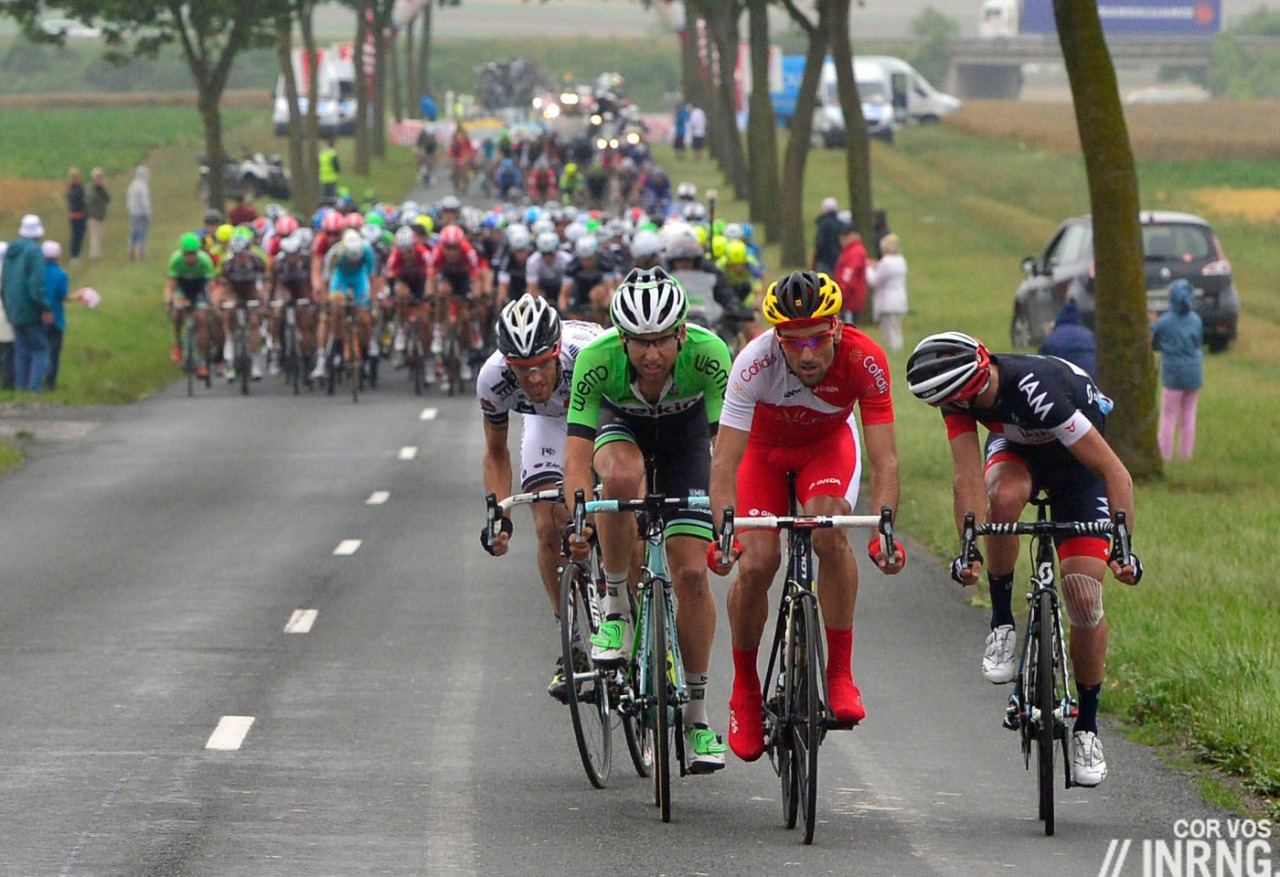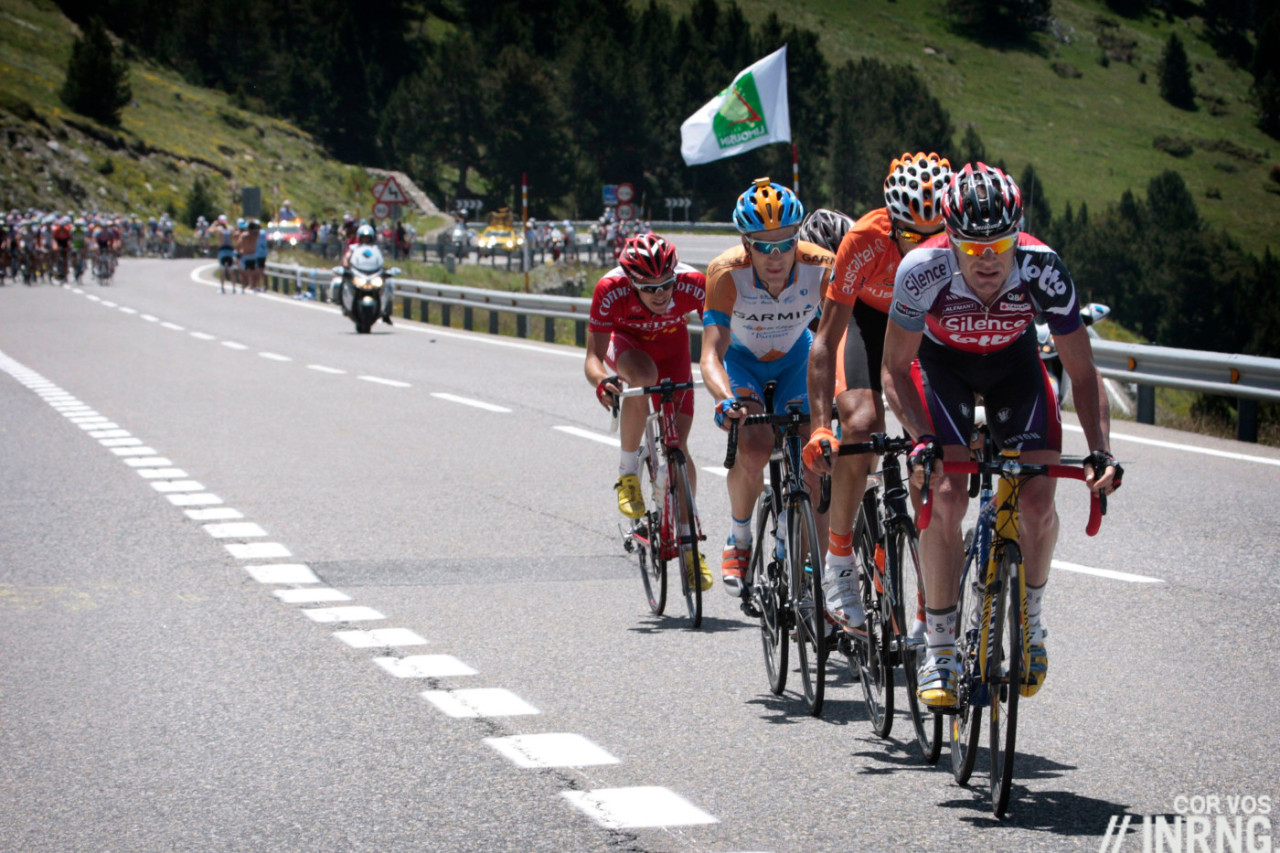
Several stages have been shown live on TV so far and sometimes there’s a fierce battle to get in the break the suddenly the bunch suddenly sits up and the breakaway is allowed to ride away. How? Why?
A breakaway is like cooking, you need the right ingredients. For a move to go clear it needs the right mix:
- In the positive sense this means several teams want to have at least one rider in the move and they’ll battle until this happens, chasing down any escapees if they’ve missed the move or sending men across
- In the negative sense some teams need to monitor who goes up the road in order to protect their GC leader. It’s improbable but for the sake of example were Richie Porte to infiltrate an early breakaway Astana would chase it down
Teams will have riders near the front of the bunch to monitor events. It’s typically called “filtering”, let those riders through who you don’t mind going up the road but to catch the ones you’re worried about. Teams might have race radios but they’re not much use here, if a move goes up the road a team needs to identify the riders instantly so they can jump on the wheel. Wait for race radio to identify the riders and an order from the team cars and there’s a gap to close.

It can work in other ways too, for example if a GC contender gets a breakaway then the move might not be shut down, it’ll just be kept on a tight leash instead. Sometimes we’ve seen examples of a rider sitting up in a breakaway because their presence in the move ruins the chances of the others. Once they drop back, they breakaway is allowed more space. An example was in 2009 when Cadel Evans took off after 20km in a stage in the Pyrenees but was persuaded by others in the breakaway to sit up because Astana were chasing too hard.
All of this makes it sound easy but imagine a day when the first hour covers 50km or more, hills included. Being able to note who’s doing what is not easy. Sometimes the elastic will simply snap, riders can’t go on chasing. But sometimes the break simply has the right mix of riders and those who missed the move might want to attack but find their colleagues are sitting up.
The race can naturally sit up but often it takes someone to call a truce or signal the move up the road has permission to go. In one of the unwritten rules of the bunch, the yellow jersey or another patron at the front of the bunch will sit up, pull over and… take a pee. Given one of the bunch’s unwritten rules is not to attack the yellow jersey when he’s stopped, this “natural break” allows the breakaway to go clear. It’s not just the act of one rider, should a big name stop then others will follow suit. There’s the reverse causality, namely that once the right breakaway’s gone up the road then it’s time for a quick pause before work resumes. Surely cycling is the only sport where the pause pipi is a tactical signal?

It might be lunchtime in France but since we’re on the delicate subject of “stopping”… the duration makes this one of the rare sports where competitors urinate during the event. Riders have a pick discreet spot and not for modesty, being caught near spectators brings a fine for “damaging the image of cycling” and a 50 Swiss Franc (€40) penalty. Easier said than done when big crowds are out.
Not everyone stops, some riders do it on the go. Practice makes perfect as Lars Boom tells Le Monde’s amusing Tour blog “yes in fact I’ve been training to piss on the bike“. But what if a rider needs more than a pee, for example of they’ve got diarrhoea? Ex-pro Jacky Durand reveals his technique Pédale magazine:
“You’ve got to find a little woodland, maybe get 50 metres away from the route. It was in these moments that my good old cap was most useful. You just had to hope a spectator didn’t stumble upon it, otherwise what a souvenir!”
Conclusion
Who goes up the road in a breakaway is essential for the breakaway’s chances and teams will monitor the attacks, filtering the riders allowed up the road. It’s much better to do this immediately by eye rather than waiting for orders from a team car. If the right riders go clear the breakaway is given its chance and a collective natural break marks the start of “Phase 2”, when the race settles down with a team or two moves to the front of the bunch to set a pace appropriate enough not to let the move get too far away.

With the ‘on the go’ technique, practice very much makes perfect. I seem to recall that Yauheni Hutarovich spectacularly misjudged the wind-conditions during the 2009 TDF and made himself unpopular with a vast swathe of the peloton.
Superb photos (again) to illustrate (another) enlightening piece.
I seem to remember LeMond’s response to having “the runs” was to use a Domestique’s cap… whilst on the move. (as per the intro to Richard Moore’s excellent book “Slaying the Badger”)
I read a very similar story about Robert Millar who threw away such a soiled cap, only to see an unsuspecting child pick it up…
The Lemond incident might have been the one described by Paul Kimmage in ‘Rough Ride’…”LeMond was in trouble today. He had a bout of diarrhoea. He rode by me with 30 kilometres to go, surrounded by his domestiques bringing him to the front. God, the smell was terrible. It was rolling down his legs”
Lovely!!
Sounds like the perfect time to attack- who’d want to hold your wheel? 😀
eh. Oh my god. I can smell it sitting on my sofa. Thanks for enlightening my imagination Paul.
Another example of GC rider sitting up would possibly be Nibali in 2012.
Are you sure thats not something else?
I suppose one sign of the sport’s success would be finding fewer spots for discreet nature breaks.
Gee a bit rude of Cadel there peeing in front of somebody’s front door! Or is it an honour in Italy to have the Magila Rosa pee on your doorstep?
I was thinking the exact same thing…imagine doing in this location just walking down the road…
He’s not peeing he’s marking his territory.
“Surely cycling is the only sport where the pause pipi is a tactical signal?”
I wasn’t aware this was the preferred signal in the peloton – interesting. Toilet breaks can be used for tactical purposes in tennis.
In his book, David Millar referred to Christian Vandevelde’s stowing of baby wipes in his jersey pocket should such a need arise, and the hedgerow was called for!
I recall seeing Ivan Basso surrounded by teammates relieving himself while on the move. But enough of the toilet talk.
The start of stages can often be more entertaining than the rest of the stage. I recall stage 9 of last years TdF where the so called break never got more than two minutes. The peloton refused to let it go, the composition of the break constantly changed with attacks and counterattacks. Finally a smallish group led by Garmin got organized, but, with Saxo determined to ride Team Sky into the dirt, it never got far.